Economic and Environmental Feasibility of Cogeneration from Food Waste: A Case Study in São Paulo City
Abstract
1. Introduction
Energy from Biogas
| Gas | Symbol | Biogas Concentration (%) |
|---|---|---|
| Methane | CH4 | 50–80 |
| Carbon dioxide | CO2 | 20–40 |
| Hydrogen | H2 | 1.0–3.0 |
| Nitrogen | N2 | 0.5–3.0 |
| Sulphide and others | H2S, CO, NH3 | 1.0–5.0 |
| Biogas energy conversion (kWh) | 1.43 | |
2. Methods
2.1. Plant Installation Design
2.2. Economic and Environmental Assessment
3. Results and Discussion
3.1. Economic Analysis
3.2. Environmental Analysis
- -
- Mitigates organic waste accumulation (e.g., food waste) and waste disposal;
- -
- Converts waste into renewable energy;
- -
- Decreases greenhouse gas emissions;
- -
- Recycles organic materials utilized into fertilizer, characterized by high quality and minimal odour;
- -
- Reduces its internal costs with energy.
4. Conclusions
Author Contributions
Funding
Institutional Review Board Statement
Informed Consent Statement
Data Availability Statement
Acknowledgments
Conflicts of Interest
References
- Bianco, G.; Bonvini, B.; Bracco, S.; Delfino, F.; Laiolo, P.; Piazza, G. Key performance indicators for an energy community based on sustainable technologies. Sustainability 2021, 13, 8789. [Google Scholar] [CrossRef]
- Azman, S.; Khadem, A.F.; Van Lier, J.B.; Zeeman, G.; Plugge, C.M. Presence and role of anaerobic hydrolytic microbes in conversion of lignocellulosic biomass for biogas production. Crit. Rev. Environ. Sci. Technol. 2015, 45, 2523–2564. [Google Scholar] [CrossRef]
- de Souza Machado, A.C.C.; Filho, G.L.T.; de Abreu, T.M.; Facchini, F.; da Silva, R.F.; Pinto, L.F.R. Use of Balanced Scorecard (BSC) Performance Indicators for Small-Scale Hydropower Project Attractiveness Analysis. Energies 2023, 16, 6615. [Google Scholar] [CrossRef]
- Pinto, L.F.R.; Tucci, H.N.P.; Mummolo, G.; Neto, G.C.d.O.; Facchini, F. Circular Economy Approach on Energy Cogeneration in Petroleum Refining. Energies 2022, 15, 1713. [Google Scholar] [CrossRef]
- Pereira, F.; Silva, C. Energetic Valorization of Bio-Waste from Municipal SolidWaste in Porto Santo Island. Clean Technol. 2023, 5, 233–258. [Google Scholar] [CrossRef]
- Drofenik, J.; Urbancl, D.; Goricanec, D.; Kravanja, Z.; Novak Pintaric, Z. Food Waste to Energy through Innovative Coupling of CHP and Heat Pump. Energies 2023, 16, 3344. [Google Scholar] [CrossRef]
- Sidek, N.F.; Harun, N.; Liyana, F.N.; Zamri, M. Simulation of an Integrated Anaerobic Digestion and Combined Heat and Power System for Food Waste Utilization. Chem. Eng. Technol. 2022, 45, 1454–1460. [Google Scholar] [CrossRef]
- Shimako, A.H.; Tiruta-Barna, L.; Pign, Y.; Benetto, E.; Gutiérrez, T.N.; Guiraud, P.; Ahmadi, A. Environmental assessment of bioenergy production from microalgae based systems. J. Clean. Prod. 2016, 139, 51–60. [Google Scholar] [CrossRef]
- Tufvesson, L.M.; Lantz, M.; Börjesson, P. Environmental performance of biogas produced from industrial residues including competition with animal feed—Life-cycle calculations according to different methodologies and standards. J. Clean. Prod. 2013, 53, 214–223. [Google Scholar] [CrossRef]
- Fusi, A.; Bacenetti, J.; Fiala, M.; Azapagic, A. Life Cycle Environmental Impacts of Electricity from Biogas Produced by Anaerobic Digestion. Front. Bioeng. Biotechnol. 2016, 4, 26. [Google Scholar] [CrossRef]
- Torrijos, M. State of Development of Biogas Production in Europe. Procedia Environ. Sci. 2016, 35, 881–889. [Google Scholar] [CrossRef]
- Riva, C.; Schievano, A.; D’Imporzano, G.; Adani, F. Production costs and operative margins in electric energy generation from biogas. Full-scale case studies in Italy. Waste Manag. 2014, 34, 1429–1435. [Google Scholar] [CrossRef] [PubMed]
- Kumar, R.; Kumar, V.; Nagpure, A.S. Bio-energy potential of available livestock waste and surplus agriculture crop residue: An analysis of 602 rural districts of India. Sci. Total Environ. 2023, 889, 163974. [Google Scholar] [CrossRef]
- Santos, I.F.S.; Barros, M.B.; Tiago Filho, G.L. Electricity generation from biogas of anaerobic wastewater treatment plants in Brazil: An assessment of feasibility and potential. J. Clean. Prod. 2016, 126, 504–514. [Google Scholar] [CrossRef]
- Cardeña, R.; Moreno, G.; Bakonyi, P.; Buitrón, G. Enhancement of methane production from various microalgae cultures via novel ozonation pretreatment. Chem. Eng. J. 2017, 307, 948–954. [Google Scholar] [CrossRef]
- Castrillón, L.; Fernández-Nava, Y.; Ormaechea, P.; Marañón, E. Optimization of biogas production from cattle manure by pre-treatment with ultrasound and co-digestion with crude glycerine. Bioresour. Technol. 2011, 102, 7845–7849. [Google Scholar] [CrossRef] [PubMed]
- Hadin, A.; Eriksson, O. Horse manure as feedstock for anaerobic digestion. Waste Manag. 2016, 56, 506–518. [Google Scholar] [CrossRef]
- Insam, H.; Gómez-Brandón, M.; Ascher, J. Manure-based biogas fermentation residues—Friend or foe of soil fertility? Soil Biol. Biochem. 2015, 84, 1–14. [Google Scholar] [CrossRef]
- Bougnom, B.P.; Niederkofler, C.; Knapp, B.A.; Stimpfl, E.; Insam, H. Residues from renewable energy production: Their value for fertilizing pastures. Biomass Bioenergy 2012, 39, 290–295. [Google Scholar] [CrossRef]
- Akbulut, A.; Kose, R.; Akbulut, A. Technical and Economic Assessments of Biogas Production in a Family Size Digester Utilizing Different Feedstock Rotations: Döğer Case Study. Int. J. Green Energy 2014, 11, 113–128. [Google Scholar] [CrossRef]
- Guares, S.A.; Lima, J.D.; Oliveira, G.A. Techno-economic model to appraise the use of cattle manure in biodigesters in the generation of electrical energy and biofertilizer. Biomass Bioenergy 2021, 150, 106107. [Google Scholar] [CrossRef]
- Dranka, G.G.; Cunha, J.; Lima, J.D.; Ferreira, P. Economic evaluation methodologies for renewable energy projects. AIMS Energy 2020, 8, 339–364. [Google Scholar] [CrossRef]
- Jonge, N.; Davidson, A.; Jansen, J.C.; Nielsen, J.L. Characterisation of microbial communities for improved management of anaerobic digestion of food waste. Waste Manag. 2020, 117, 124–135. [Google Scholar] [CrossRef] [PubMed]
- Kaza, S.; Yao, L.; Perinaz, B.-T.; Van Woerden, F. What a Waste 2.0: A Global Snapshot of Solid Waste Management to 2050; Urban Development Series; World Bank: Washington, DC, USA, 2018. [Google Scholar] [CrossRef]
- Oliveira, L.B.; Rosa, L.P. Brazilian waste potential: Energy, environmental, social and economic benefits. Energy Policy 2003, 31, 1481–1491. [Google Scholar] [CrossRef]
- Barros, R.M.; Tiago Filho, G.L.; Silva, T.R. The electric energy potential of landfill biogas in Brazil. Energy Policy 2014, 65, 150–164. [Google Scholar] [CrossRef]
- Antonelli, J.; Lindino, C.A.; Azevedo, J.C.R.; Souza, S.N.M.; Cremonez, P.A.; Rossi, E. Biogas production by the anaerobic digestion of whey. Revista Ciênc. Agrar. 2016, 39, 463–467. [Google Scholar] [CrossRef]
- Calza, L.F.; de Lima, C.B.; Nogueira, C.E.C.; Siqueira, J.A.C.; Santos, R.F. Cost assessment of biodigester implementation and biogas produced energy. Eng. Agric. 2015, 35, 990–997. [Google Scholar] [CrossRef]
- Neto, J.G.; Ozorio, L.V.; Abreu, T.C.C.; Santos, B.F.; Pradelle, F. Modeling of biogas production from food, fruits and vegetables wastes using artificial neural network (ANN). Fuel 2021, 285, 119081. [Google Scholar] [CrossRef]
- Mendieta, O.; Castro, L.; Escalante, H.; Garfi, M. Low-cost anaerobic digester to promote the circular bioeconomy in the non-centrifugal cane sugar sector: A life cycle assessment. Bioresour. Technol. 2021, 326, 124783. [Google Scholar] [CrossRef]
- Lansche, J.; Müller, J. Life cycle assessment (LCA) of biogas versus dung combustion household cooking systems in developing countries—A case study in Ethiopia. J. Clean. Prod. 2017, 165, 828–835. [Google Scholar] [CrossRef]
- Garfí, M.; Castro, L.; Montero, N.; Escalante, H.; Ferrer, I. Evaluating environmental benefits of low-cost biogas digesters in small-scale farms in Colombia: A life cycle assessment. Bioresour. Technol. 2019, 274, 541–548. [Google Scholar] [CrossRef] [PubMed]
- Carvalho, B.V.; Melo e Sousa, A.P.; Soto, F.R.M. Evaluation of environmental management systems on swine farms. Revista Ambiente Água 2015, 10, 164–171. [Google Scholar] [CrossRef][Green Version]
- Benvenga, M.A.C.; Librantz, A.F.H.; Santana, J.C.C.; Tambourgi, E.B. Genetic algorithm applied to study of the economic viability of alcohol production from Cassava root from 2002 to 2013. J. Clean. Prod. 2016, 113, 483–494. [Google Scholar] [CrossRef]
- Giraçol, J.; Passarini, K.C.; Silva Filho, S.C.; Calarge, F.A.; Tambourgi, E.B.; Santana, J.C.C. Reduction in ecological cost through biofuel production from cooking oils: An ecological solution for the city of Campinas, Brazil. J. Clean. Prod. 2011, 19, 1324–1329. [Google Scholar] [CrossRef]
- Basseto, L.I.; Silva, C.L.; Rocha Junior, W.F. Mercado de carbono e instituições: Oportunidades na busca por um novo modelo de desenvolvimento. Interciencia 2012, 37, 8–13. [Google Scholar]
- Goldemberg, J.; Coelho, S.T. Bioenergy: How much? Environ. Res. Lett. 2013, 8, 031005. [Google Scholar] [CrossRef][Green Version]
- Chaves, L.I.; da Silva, M.J.; de Souza, M.S.N.; Secco, D.; Rosa, H.A.; Nogueira, C.E.C.N.; Frigo, E.P. Small-scale power generation analysis: Downdraft gasifier coupled to engine generator set. Renew. Sustain. Energy Rev. 2016, 58, 491–498. [Google Scholar] [CrossRef]
- Ajay, C.M.; Mohan, S.; Dinesha, P. Decentralized energy from portable biogas digesters using domestic kitchen waste: A review. Waste Manag. 2021, 125, 10–26. [Google Scholar] [CrossRef] [PubMed]
- Ristinen, R.A.; Kraushaar, J.P. Energy and the Environment, 2nd ed.; Wiley: New York, NY, USA, 2005; p. 384. [Google Scholar]
- Souza, S.N.M.; Pereira, W.C.; Nogueira, C.E.C.; Pavan, A.A.; Sordi, A. Cost of electricity by hog raising biogas in group engine generators. Acta Sci. Technol. 2004, 26, 127–133. [Google Scholar] [CrossRef]
- Borges Neto, M.R.; Carvalho, P.C.M.; Carioca, J.O.B.; Canafístula, F.J.F. Biogas/photovoltaic hybrid power system for decentralized energy supply of rural areas. Energy Policy 2010, 38, 4497–4506. [Google Scholar] [CrossRef]
- Zhang, M.; Zhang, Y.; Zhenqwen, L.; Zhang, C.; Tan, Z.; Liu, X.; Wan, C.; Yang, X.; Lee, D.J. Anaerobic co-digestion of food waste/excess sludge: Substrates—Products transformation and role of NADH as an indicator. J. Environ. Manag. 2019, 232, 197–206. [Google Scholar] [CrossRef] [PubMed]
- Kim, M.; Chowdhury, M.M.I.; Nakhla, G.; Keleman, M. Synergism of co-digestion of food wastes with municipal wastewater treatment biosolids. Waste Manag. 2017, 61, 473–483. [Google Scholar] [CrossRef] [PubMed]
- Dalke, R.; Demro, D.; Khalid, Y.; Wu, H.; Dermitas, M.U. Current status of anaerobic digestion of food waste in the United States. Renew. Sustain. Energy Rev. 2021, 151, 111554. [Google Scholar] [CrossRef]
- Li, W.; Guo, J.B.; Cheng, H.C.; Wang, W.; Dong, R.J. Two-phase anaerobic digestion of municipal solid wastes enhanced by hydrothermal pretreatment: Viability, performance and microbial community evaluation. Appl. Energy 2017, 189, 613–622. [Google Scholar] [CrossRef]
- Turdera, M.V.; Yura, D. Estudo da viabilidade de um biodigestor no município de dourados. In Proceedings of the 6th Encontro de Energia no Meio Rural, Campinas, Brazil, 6–8 June 2006; Available online: http://www.proceedings.scielo.br/scielo.php?script=sci_arttext&pid=MSC0000000022006000100062&lng=en&nrm=iso (accessed on 20 December 2023).
- Sahu, P.K. Research Methodology: A Guide for Researchers. In Agricultural Science, Social Science and Other Related Fields; Springer: New Delhi, India, 2013; p. 432. [Google Scholar]
- General Electric. Some Energy Lasts for Generations. Available online: https://www.jenbacher.com/en/energy-solutions/energy-sources/biogas (accessed on 18 October 2023).
- Jesus, R.H.G.; Souza, J.T.; Piglieri, F.N.; Pierkarski, C.M.; Francisco, A.C. Biodigester location problems, its economic–environmental–social aspects and techniques: Areas yet to be explored. Energy Rep. 2021, 7, 3998–4008. [Google Scholar] [CrossRef]
- Jyothilakshmi, R.; Praskash, S.V. Design, fabrication and experimentation of a small scale anaerobic biodigester for domestic biodegradable solid waste with energy recovery and sizing calculation. Procedia Environ. Sci. 2016, 35, 749–755. [Google Scholar] [CrossRef]
- Passarini, K.C.; Pereira, M.A.; Farias, T.M.B.; Calarge, F.A.; Santana, C.C. Assessment of the viability and sustainability of an integrated waste management system for the city of Campinas (Brazil), by means of ecological cost accounting. J. Clean. Prod. 2014, 65, 479–488. [Google Scholar] [CrossRef]
- Silva Filho, S.C.; Miranda, A.C.; Silva, T.A.F.; Calarge, F.A.; Souza, R.R.; Santana, J.C.C.; Tambourgi, E.B. Data on kinetic, energy and emission performance of biodiesel from waste frying oil. Data Brief 2018, 18, 1224–1228. [Google Scholar] [CrossRef] [PubMed]
- Miranda, A.C.; Silva Filho, S.C.; Tambourgi, E.B.; Curvelo Santana, J.C.; Vanalle, R.M.; Guerhardt, F. Analysis of the costs and logistics of biodiesel production from used cooking oil in the metropolitan region of Campinas (Brazil). Renew. Sustain. Energy Rev. 2018, 88, 373–379. [Google Scholar] [CrossRef]
- Avaci, A.B.; Souza, S.N.M.; Chaves, L.I.; Nogueira, E.C.; Niedzialkoski, R.K.; Secco, D. Avaliação econômico-financeira da microgeração de energia elétrica proveniente de biogás da suinocultura. Rev. Bras. Eng. Agric. Ambient. 2014, 17, 456–462. [Google Scholar] [CrossRef]
- Guerra Sgorlon, J.; Rizk, M.C.; Bergamasco, R.; Granhen Tavares, C.R. Avaliação da DQO e da relação C/N obtidas no tratamento anaeróbio de resíduos fruti-hortículas. Acta Sci. Technol. 2011, 33, 421–424. [Google Scholar] [CrossRef]
- Gyalpo, T. Anaerobic Digestion of Canteen Waste at a Secondary School in Dar es Salaam, Tanzania; Swiss Federal Institute of Aquatic Science and Technology (Eawag): Dübendorf, Switzerland, 2010. [Google Scholar]
- Alkanok, G.; Demirel, B.; Onay, T.T. Determination of biogas generation potential as a renewable energy source from supermarket wastes. Waste Manag. 2014, 34, 134–140. [Google Scholar] [CrossRef] [PubMed]
- Kuczman, O.; Gueri, M.V.D.; Souza, S.N.M.; Schirmer, W.N.; Alves, J.E.; Secco, D.; Buratto, W.G.; Ribeiro, C.B.; Hernandes, F.B. Food waste anaerobic digestion of a popular restaurant in Southern Brazil. J. Clean. Prod. 2018, 196, 382–389. [Google Scholar] [CrossRef]
- Granzotto, F.; Aita, C.; Silveira, D.D.; Mayer, F.D.; Pujol, S.B.; Pinas, J.A.V.; Hoffmann, R. Use of anaerobic biodigestor in the treatment of organic waste from a university restaurant. J. Environ. Chem. Eng. 2021, 9, 105795. [Google Scholar] [CrossRef]
- Ogejo, J.A.; Li, L. Enhancing biomethane production from flush dairy manure with turkey processing wastewater. Appl. Energy 2010, 87, 3171–3177. [Google Scholar] [CrossRef]
- Silva, F.B.; Zaneti, I.C.; Silva, G.O. Implementação do reator artesanal para biodigestão anaeróbia de resíduos alimentares do restaurante universitário da UNB. In Proceedings of the 9th Fórum Internacional de Resíduos Sólidos, Porto Alegre, Brazil, 13–15 June 2018; Instituto Venturi: Porto Alegre, Brazil, 2018; pp. 1–9. Available online: https://www.institutoventuri.org.br/ojs/index.php/firs/article/view/763 (accessed on 20 December 2023).
- Franca, L.S.; Bassin, J.P. The role of dry anaerobic digestion in the treatment of the organic fraction of municipal solid waste: A systematic review. Biomass Bioenergy 2020, 143, 105866. [Google Scholar] [CrossRef]
- Silva, J.P.; Berwing, K.H.; Dettmers, A. Obtenção de biogás a partir de combinações de resíduos de arroz e esterco suíno. In Proceedings of the XX Congresso Brasileiro de Engenharia Química, Florianópolis, Brazil, 19–22 October 2017. [Google Scholar]
- Wang, L.; Yang, C.; Xu, Z.; Yuan, G.; Tang, L.; Bai, Y.; Wang, X. Analysis of carbon electricity coupled market modeling method based on carbon credit trading mechanism. Int. J. Electr. Power Energy Syst. 2024, 156, 109707. [Google Scholar] [CrossRef]
- Farezin, E.C.; Sarubbi, J.; Morais, J.L.R.; Junior, W.H.; Soto, F.R.M. Análise ambiental, sanitária e econômica de um sistema de tratamento de resíduos sólidos e efluentes em uma granja de suínos. Veterinária e Zootec. 2018, 25, 164–172. [Google Scholar] [CrossRef]
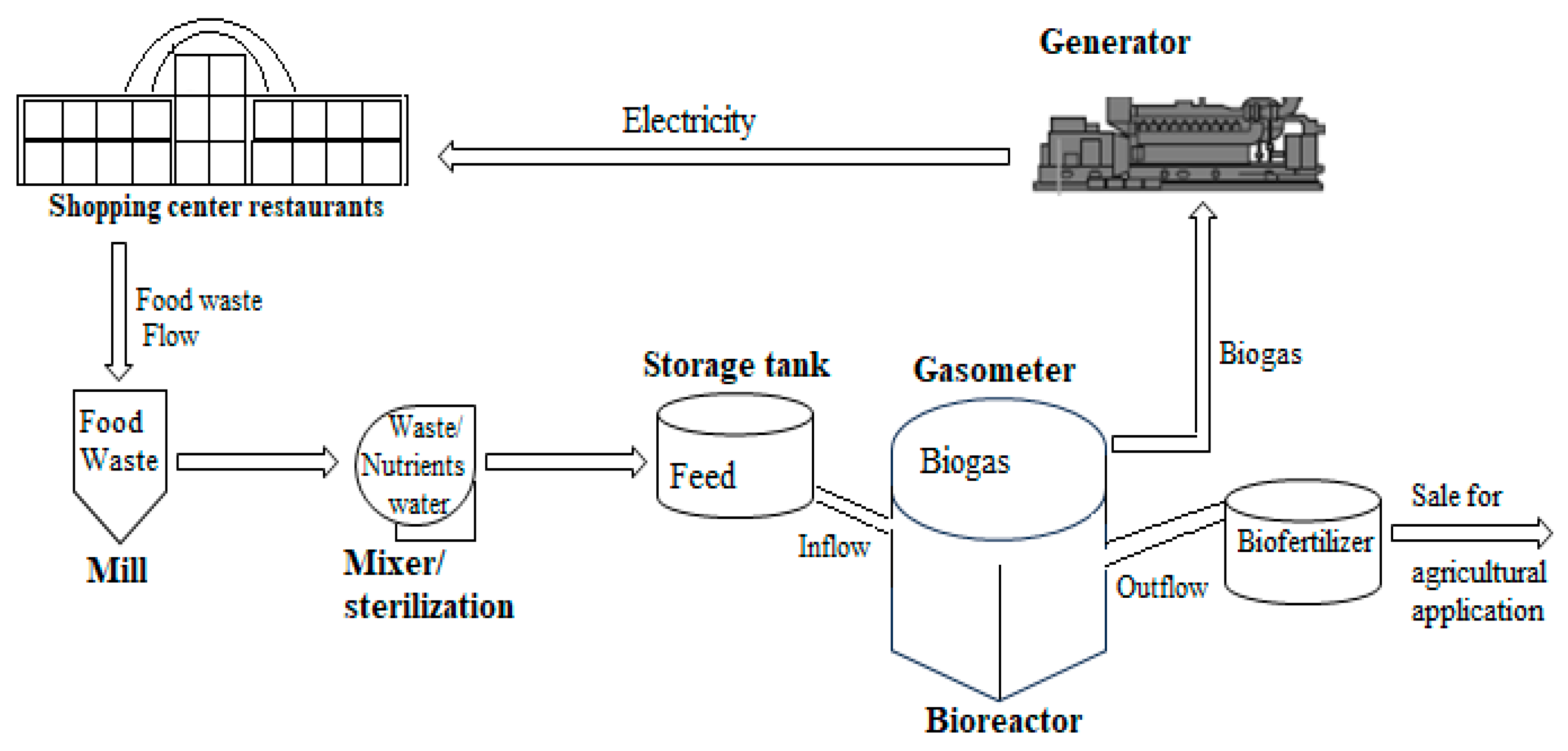
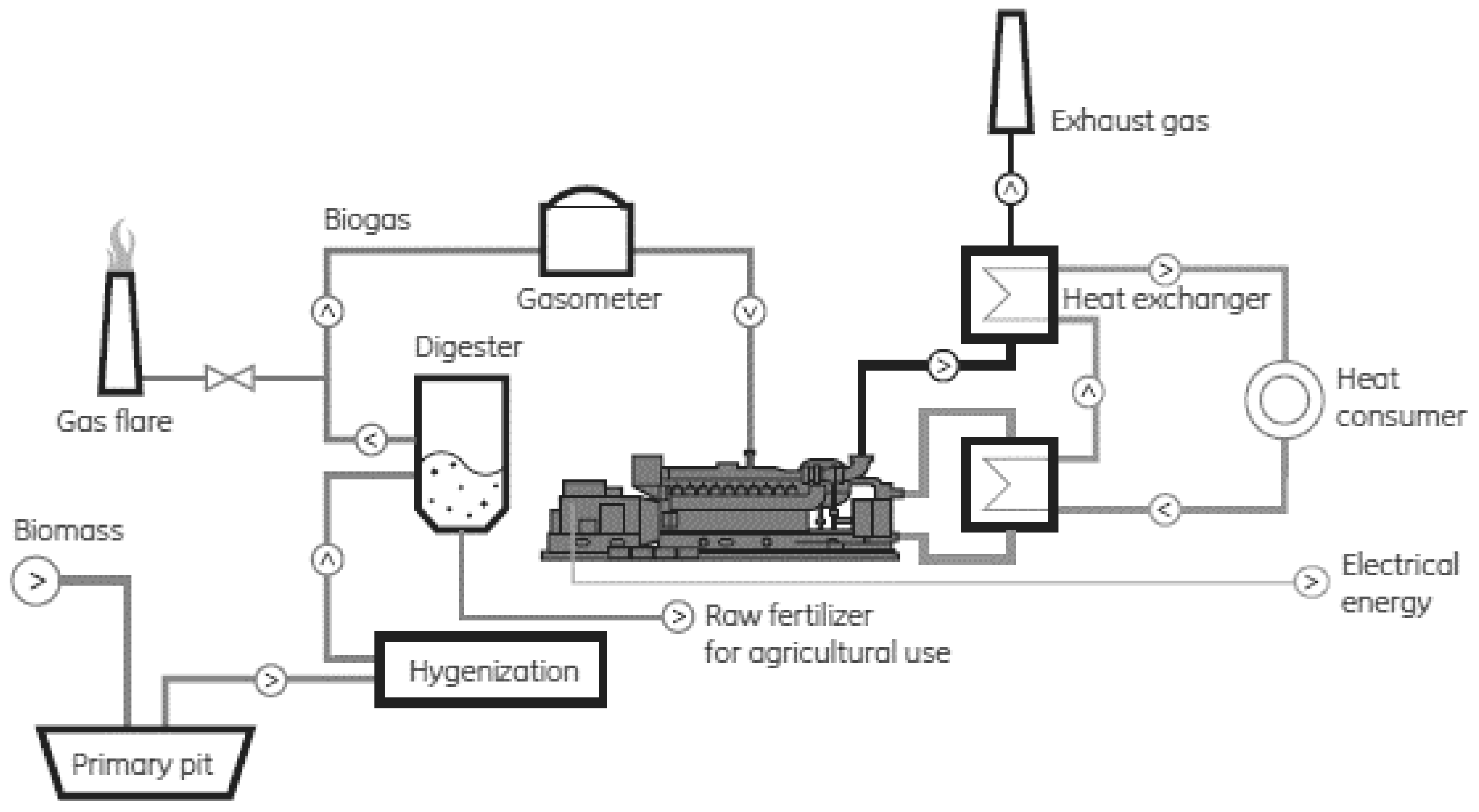
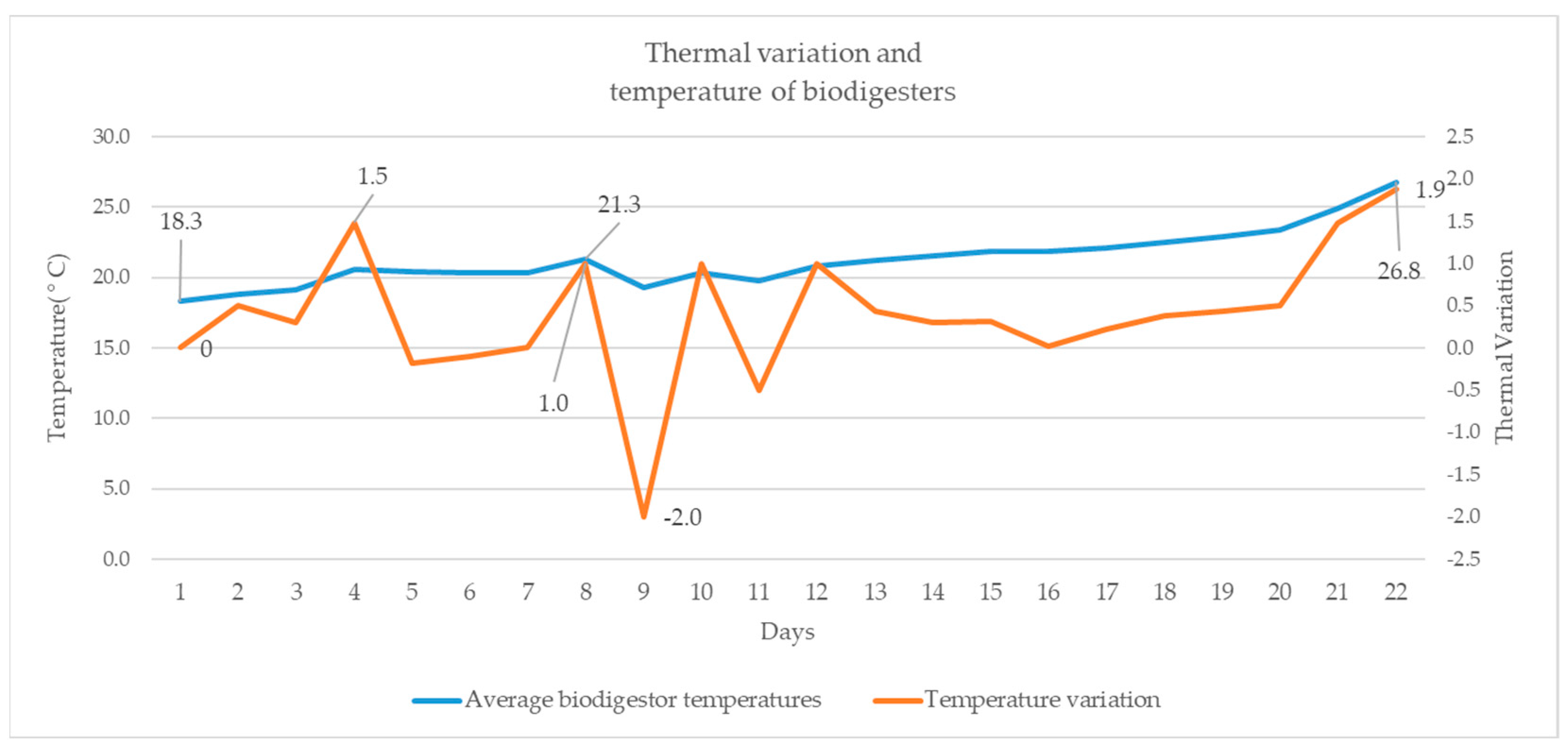
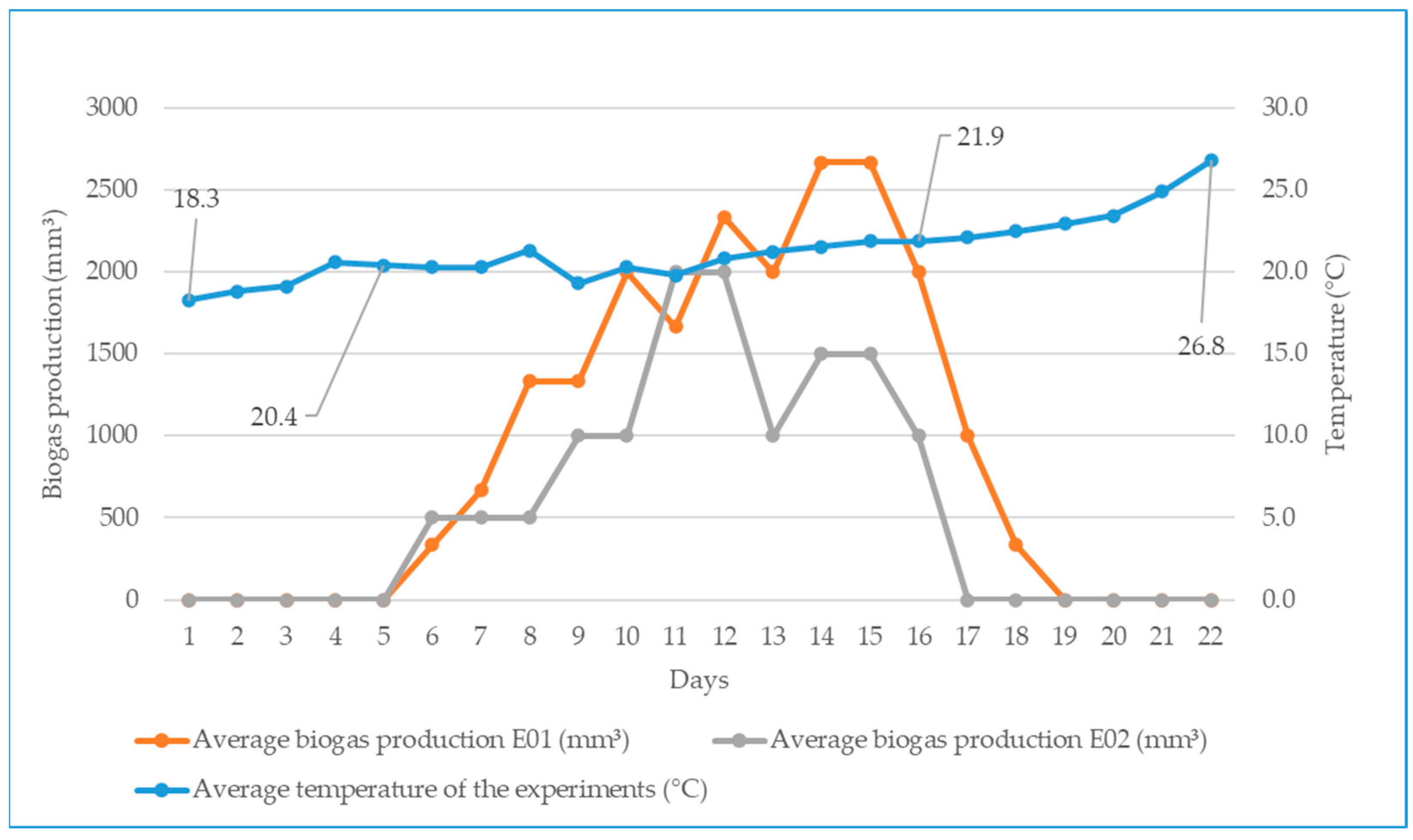
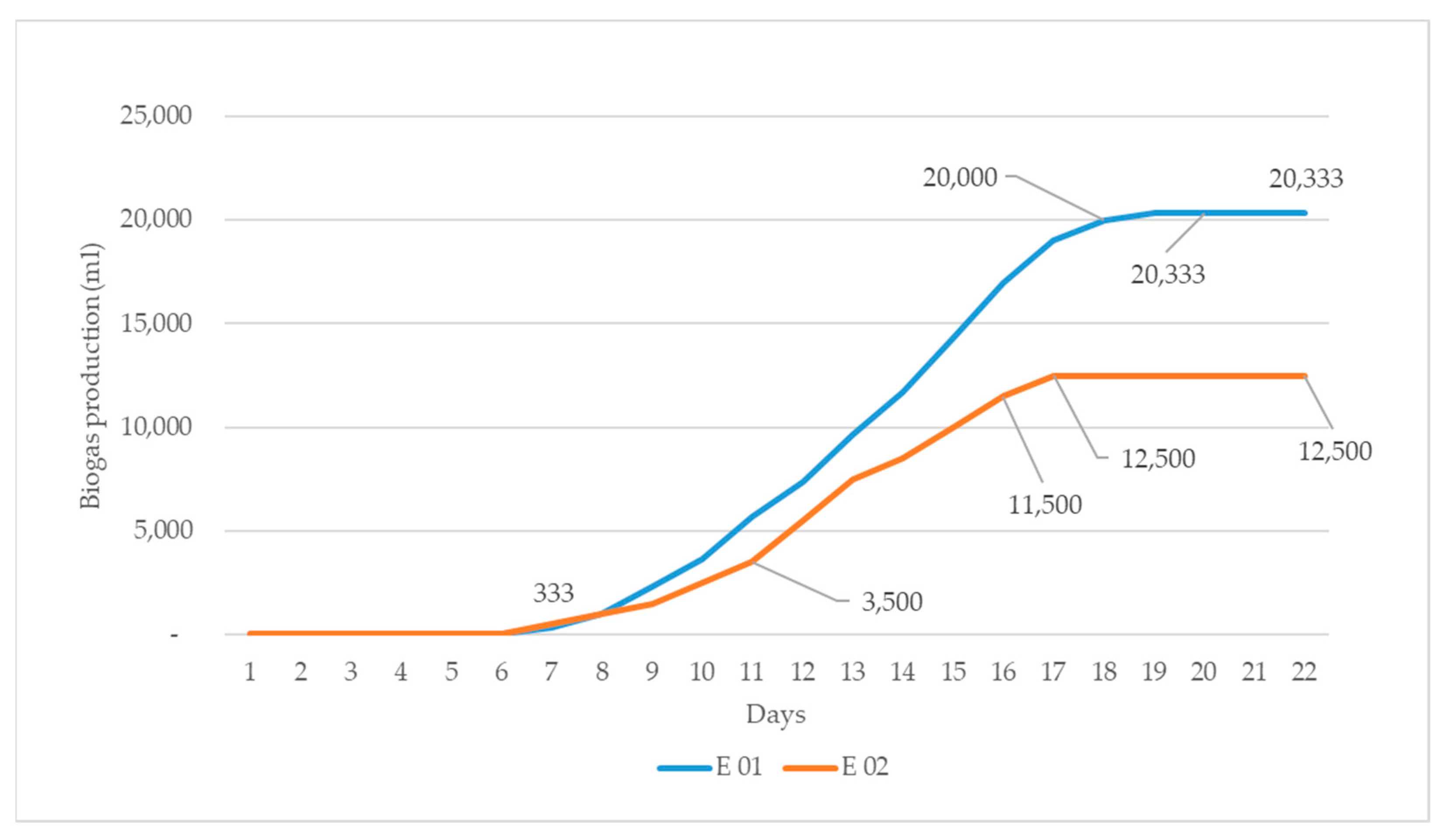
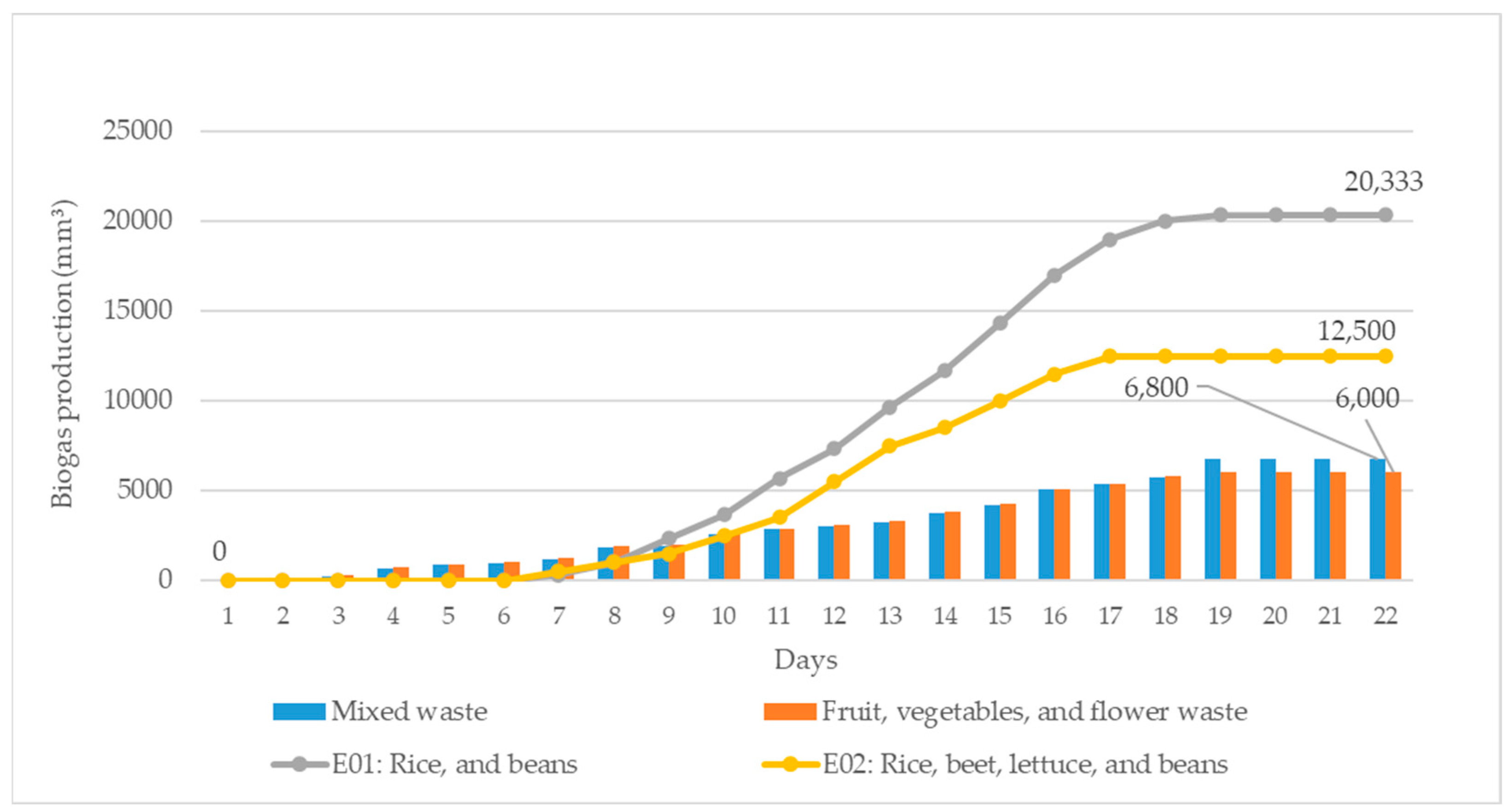
| Description | E1 | E2 | Units |
|---|---|---|---|
| Total average | 20,333 | 12,500 | mL/day |
| Average time | 13 | 12 | day |
| Average production rate | 1564 | 1042 | mL/day |
| Average minimum rate | 333 | 500 | mL/day |
| Maximum average rate | 2667 | 2000 | mL/day |
| Standard deviation mean | 809 | 552 | mL/day |
| Total average productivity | 40,666 | 25,000 | mL/kg |
| Daily average productivity | 3128 | 2083 | mL/kg |
| Experiments | Initial Mass [kg] | Final Mass [kg] | Loss of Matter [kg] | pH | |
|---|---|---|---|---|---|
| Initial | Final | ||||
| E1 | 500 | 477.70 | 22.30 | 6.6 | 6.8 |
| E2 | 500 | 484.60 | 15.40 | 6.6 | 7.0 |
| Description | Unit | Values |
|---|---|---|
| Generator cost estimation | USD | 674,171.00 |
| Biodigester cost estimation | USD | 23,809.52 |
| Maintenance cost | USD | 269.67 |
| Electricity production | kWh/y | 6,570,000.00 |
| Unitary energy cost | USD/kWh | 0.10 |
| Biomass used | kg/month | 4,500,000 |
| Investment | USD | 713,000.00 |
| Financial rate | %, a.y. | 7.15 |
| Instalments | USD/y | 102,220.20 |
| Net present value (NPV) | USD | 3,087,820.53 |
| Return on investiment (ROI) | % | 433% |
| Payback | Year | 1.01 |
Disclaimer/Publisher’s Note: The statements, opinions and data contained in all publications are solely those of the individual author(s) and contributor(s) and not of MDPI and/or the editor(s). MDPI and/or the editor(s) disclaim responsibility for any injury to people or property resulting from any ideas, methods, instructions or products referred to in the content. |
© 2024 by the authors. Licensee MDPI, Basel, Switzerland. This article is an open access article distributed under the terms and conditions of the Creative Commons Attribution (CC BY) license (https://creativecommons.org/licenses/by/4.0/).
Share and Cite
de Oliveira, D.E.P.; Miranda, A.C.; Junior, M.V.; Santana, J.C.C.; Tambourgi, E.B.; Facchini, F.; Iavagnilio, R.; Pinto, L.F.R. Economic and Environmental Feasibility of Cogeneration from Food Waste: A Case Study in São Paulo City. Sustainability 2024, 16, 2979. https://doi.org/10.3390/su16072979
de Oliveira DEP, Miranda AC, Junior MV, Santana JCC, Tambourgi EB, Facchini F, Iavagnilio R, Pinto LFR. Economic and Environmental Feasibility of Cogeneration from Food Waste: A Case Study in São Paulo City. Sustainability. 2024; 16(7):2979. https://doi.org/10.3390/su16072979
Chicago/Turabian Stylede Oliveira, Douglas Eldo Pereira, Amanda Carvalho Miranda, Milton Vieira Junior, José Carlos Curvelo Santana, Elias Basile Tambourgi, Francesco Facchini, Raffaello Iavagnilio, and Luiz Fernando Rodrigues Pinto. 2024. "Economic and Environmental Feasibility of Cogeneration from Food Waste: A Case Study in São Paulo City" Sustainability 16, no. 7: 2979. https://doi.org/10.3390/su16072979
APA Stylede Oliveira, D. E. P., Miranda, A. C., Junior, M. V., Santana, J. C. C., Tambourgi, E. B., Facchini, F., Iavagnilio, R., & Pinto, L. F. R. (2024). Economic and Environmental Feasibility of Cogeneration from Food Waste: A Case Study in São Paulo City. Sustainability, 16(7), 2979. https://doi.org/10.3390/su16072979










